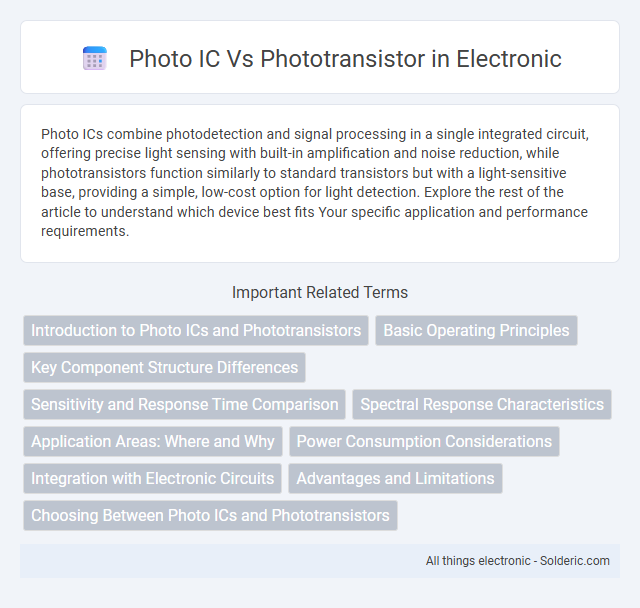Photo ICs combine photodetection and signal processing in a single integrated circuit, offering precise light sensing with built-in amplification and noise reduction, while phototransistors function similarly to standard transistors but with a light-sensitive base, providing a simple, low-cost option for light detection. Explore the rest of the article to understand which device best fits Your specific application and performance requirements.
Comparison Table
| Feature | Photo IC | Phototransistor |
|---|---|---|
| Type | Integrated circuit with photosensitive element | Semiconductor transistor activated by light |
| Sensitivity | High sensitivity with consistent response | Moderate sensitivity, varies by transistor |
| Response Speed | Fast response suitable for high-frequency signals | Slower response due to transistor properties |
| Output Signal | Digital or analog output, easier integration | Analog output, signal amplification built-in |
| Use Cases | Optical communication, light sensing, data transmission | Light detection, switching, amplification in circuits |
| Power Consumption | Lower power consumption due to IC design | Higher power consumption relative to photo IC |
| Cost | Generally higher due to complexity | Lower cost and simpler design |
Introduction to Photo ICs and Phototransistors
Photo ICs and phototransistors are semiconductor devices designed for light sensing applications. Photo ICs integrate photodetectors with signal processing circuitry, offering higher sensitivity and noise immunity compared to standalone phototransistors. Your choice between these components depends on factors like response speed, output stability, and required signal conditioning in optical systems.
Basic Operating Principles
Photo ICs use integrated circuits to convert light into electrical signals by leveraging photodiodes combined with amplification and signal processing components, allowing precise and stable output. Phototransistors operate by using light to generate electron-hole pairs in the base region, which controls current flow between the collector and emitter, resulting in a stronger electrical response compared to simple photodiodes. The key difference lies in the complex signal handling of photo ICs versus the direct current amplification mechanism in phototransistors.
Key Component Structure Differences
Photo ICs integrate photodiodes with signal processing circuits on a single chip, enhancing sensitivity and noise immunity. Phototransistors consist of a simple semiconductor structure that amplifies current generated by incident light, offering higher gain but slower response. Your choice depends on the required sensitivity and speed, as Photo ICs provide precise digital output while phototransistors deliver analog signals with greater signal amplification.
Sensitivity and Response Time Comparison
Photo ICs generally offer higher sensitivity compared to phototransistors, enabling superior detection of low light levels in your applications. Response time in photo ICs is significantly faster, often in the microsecond range, while phototransistors typically have slower response times due to carrier diffusion processes. Choosing a photo IC can enhance performance where rapid and precise light detection is critical, whereas phototransistors suit applications prioritizing simplicity and cost.
Spectral Response Characteristics
Photo ICs exhibit a broad spectral response range, typically from 400 nm to 1100 nm, enabling effective detection of visible to near-infrared light. Phototransistors have a similar spectral response but often demonstrate higher sensitivity in the visible spectrum, approximately 400 nm to 700 nm. The choice between Photo ICs and phototransistors depends on the required wavelength sensitivity and the application's need for spectral selectivity or intensity measurement.
Application Areas: Where and Why
Photo ICs excel in integrated circuits for optical communication, position sensing, and proximity detection due to their fast response time and noise immunity. Phototransistors are preferred in low-cost applications such as light detection, object sensing, and simple optical switches because of their high sensitivity and ease of use. The choice depends on factors like signal processing complexity, environmental conditions, and required switching speed.
Power Consumption Considerations
Photo ICs typically consume less power compared to phototransistors due to integrated circuits designed for efficient signal processing and low current operation. Phototransistors often require higher bias currents to achieve similar sensitivity, increasing overall power consumption in your application. Selecting a photo IC can optimize power efficiency, especially in battery-powered or energy-sensitive devices.
Integration with Electronic Circuits
Photo ICs boast superior integration with electronic circuits due to their compact, monolithic design that combines photodetection and signal processing within a single chip, reducing external components and enhancing reliability. Phototransistors require separate amplification and signal conditioning circuits, leading to increased circuit complexity and larger board space. The integration capability of photo ICs makes them ideal for applications demanding miniaturization and consistent performance in automated systems and sensor interfaces.
Advantages and Limitations
Photo ICs offer high sensitivity and fast response times, making them ideal for precise light detection in complex electronic circuits. Phototransistors provide simpler design and cost-effectiveness but have slower response times and lower linearity compared to photo ICs. Your choice depends on the application requirements, balancing sensitivity, speed, and budget constraints.
Choosing Between Photo ICs and Phototransistors
Choosing between photo ICs and phototransistors depends on your application's sensitivity, response time, and integration needs. Photo ICs offer integrated amplification and noise reduction, making them ideal for precision and stable light sensing, while phototransistors provide simpler, cost-effective solutions with faster response times but require external circuitry. Evaluate your project's complexity, required signal processing, and environmental conditions to select the optimal light detection component.
photo IC vs phototransistor Infographic

 solderic.com
solderic.com